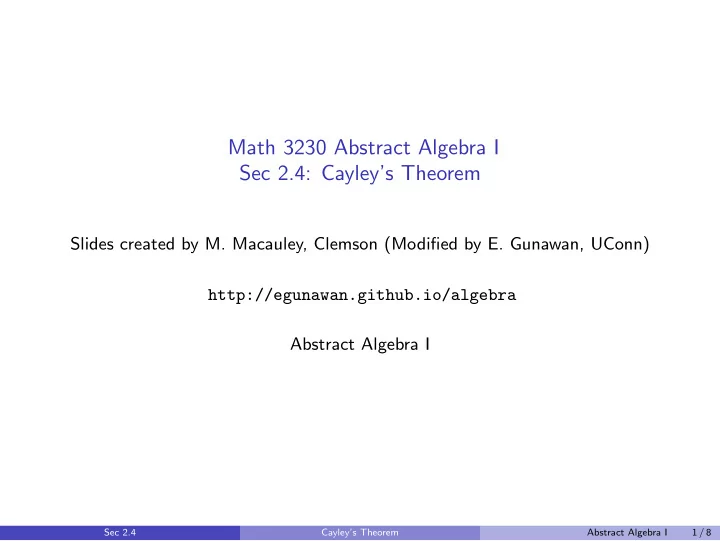

Math 3230 Abstract Algebra I Sec 2.4: Cayley’s Theorem Slides created by M. Macauley, Clemson (Modified by E. Gunawan, UConn) http://egunawan.github.io/algebra Abstract Algebra I Sec 2.4 Cayley’s Theorem Abstract Algebra I 1 / 8
Overview We have introduced these 5 families of groups: 1. cyclic groups 2. abelian groups 3. dihedral groups 4. symmetric groups 5. alternating groups In this lecture, we will introduce Cayleys theorem, which tells us that every finite group is isomorphic to a collection of permutations (i.e., a subgroup of a symmetric group). Sec 2.4 Cayley’s Theorem Abstract Algebra I 2 / 8
Cayley’s theorem Any set of permutations that forms a group is called a permutation group. Cayley’s theorem says that permutations can be used to construct any finite group. In other words, every group has the same structure as (we say “ is isomorphic to ”) some permutation group. Warning! We are not saying that every group is isomorphic to some symmetric group, S n . Rather, every group is isomorphic to a subgroup of some symmetric group S n – i.e., a subset of S n that is also a group in its own right. Question Given a group, how do we associate it with a set of permutations? Sec 2.4 Cayley’s Theorem Abstract Algebra I 3 / 8
Cayley’s theorem (an algorithm for constructing permutations) Given a Cayley diagram with n nodes: 1. number the nodes 1 through n , 2. interpret each arrow type in the Cayley diagram as a permutation. The resulting permutations are the generators of the corresponding permutation group. Example Follow the algorithm with D 3 = � r , f � . 1 1 2 3 4 5 6 4 6 5 1 2 3 4 5 6 3 2 We see that D 3 is isomorphic to the subgroup � (132)(456) , (14)(25)(36) � of S 6 . Exercise: Compute the other elements (as permutations), for example, (132)(456) (14)(25)(36) = Sec 2.4 Cayley’s Theorem Abstract Algebra I 4 / 8
Exercise A (from HW4) Label the vertices of the Cayley diagram from the set { 1 , . . . , 8 } and use this to construct a permutation group isomorphic to D 4 , and sitting inside S 8 . Sec 2.4 Cayley’s Theorem Abstract Algebra I 5 / 8
Cayley’s theorem (an algorithm to construct permutations) Here is an algorithm given a multiplication table with n elements: 1. replace the table headings with 1 through n , 2. make the appropriate replacements throughout the rest of the table, 3. interpret each row as a permutation. This gives a bijection between the original group elements (not just the generators) and permutations. Example Try this with the multiplication table for V 4 = � v , h � . Row 1: 1 2 3 4 1 2 3 4 1 1 2 3 4 Row 2: 1 2 3 4 2 2 1 4 3 Row 3: 1 2 3 4 3 3 4 1 2 4 4 3 2 1 Row 4: 1 2 3 4 We see that V 4 is isomorphic to the subgroup � (12)(34) , (13)(24) � of S 4 . The other two permutations in this subgroup are ( Sec 2.4 Cayley’s Theorem Abstract Algebra I 6 / 8
Exercise B (from HW4) e r r 2 r 3 r 2 f r 3 f f rf r 2 r 3 r 2 f r 3 f e e r f rf r 2 r 3 r 2 f r 3 f r r e rf f r 2 r 2 r 3 e r r 2 f r 3 f f rf r 3 r 3 e r r 2 r 3 f r 2 f f rf r 3 f r 2 f e r 3 r 2 r f f rf r 3 f r 2 f r e r 3 r 2 rf rf f r 2 f r 2 f r 3 f r 2 r 3 rf f r e r 3 f r 3 f r 2 f r 3 r 2 r e rf f 1. Label the entries of the multiplication table from the set { 1 , . . . , 8 } and use this to construct a permutation group isomorphic to D 4 , and sitting inside S 8 . 2. Are the two groups you got the same as the previous exercise? (The answer will depend on your choice of labeling.) If “yes”, then repeat the previous exercise with a different labeling to yield a different group. If “no”, then repeat the previous exercise with a different labeling to yield the group you got. Sec 2.4 Cayley’s Theorem Abstract Algebra I 7 / 8
Cayley’s theorem Intuitively, two groups are isomorphic if they have the same structure. Two groups are isomorphic if we can construct Cayley diagrams for each that look identical. Cayley’s Theorem Every finite group is isomorphic to a collection of permutations. Our algorithms exhibit a 1-1 correspondence between group elements and permutations. However, we have not shown that the corresponding permutations form a group, or that the resulting permutation group has the same structure as the original. We need to show that the permutation from the i th row followed by the permutation from the j th column, results in the permutation that corresponding to the cell in the i th row and j th column of the original table. Sec 2.4 Cayley’s Theorem Abstract Algebra I 8 / 8
Recommend
More recommend